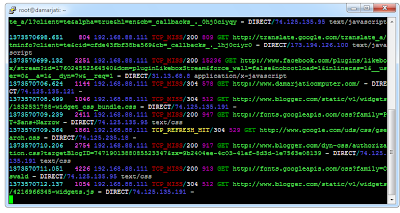Bagi anda yang bekerja sebagai seorang administrator jaringan baik di kantor,
warnet maupun personal, pasti tidak asing lagi dengan proxy, squid, dan ubuntu
dalam mengelola jaringan anda.
Dibawah ini saya cuplikkan dari Wiki Squid beberapa kode yang biasa
muncul ketika kita mengakses squid.log dari proxy yang kita bangun.
| TCP |
Permintaan akses yang melalui port HTTP (biasanya port 3128) |
| UDP |
Requests on the ICP port (usually 3130) or HTCP port (usually 4128). If
ICP logging was disabled using the log_icp_queries option, no ICP replies
will be logged. |
| NONE |
Squid delivered an unusual response or no response at all. Seen with
cachemgr requests and errors, usually when the transaction fails before being
classified into one of the above outcomes. Also seen with responses to CONNECT
requests.
|
| CLIENT |
The client request placed limits affecting the response. Usually seen with
client issued a "no-cache", or analogous cache control command along with the
request. Thus, the cache has to validate the object. |
| IMS |
The client sent a revalidation (conditional) request. |
| ASYNC |
The request was generated internally by Squid. Usually this is background
fetches for cache information exchanges, background revalidation from
stale-while-revalidate cache controls, or ESI sub-objects being loaded. |
| SWAPFAIL |
The object was believed to be in the cache, but could not be accessed. A
new copy was requested from the server. |
| REFRESH |
A revalidation (conditional) request was sent to the server. |
| NEGATIVE |
Only seen on HIT responses. Indicating the response was a cached
error response. e.g. "404 not found" |
| STALE |
The object was cached and served stale. This is usually caused by
stale-while-revalidate or stale-if-error cache controls. |
| OFFLINE |
The requested object was retrieved from the cache during offline_mode.
The offline mode never validates any object. |
| INVALID |
An invalid request was received. An error response was delivered
indicating what the problem was. |
| FAIL |
Only seen on REFRESH to indicate the revalidation request failed.
The response object may be the server provided network error or the stale
object which was being revalidated depending on stale-if-error cache
control. |
| MODIFIED |
Only seen on REFRESH responses to indicate revalidation produced a
new modified object. |
| UNMODIFIED |
Only seen on REFRESH responses to indicate revalidation produced a
304 (Not Modified) status. Which was relayed to the client. |
| REDIRECT |
Squid generated an HTTP redirect response to this request. Only on Squid-3.2+ or Squid built with
-DLOG_TCP_REDIRECTS compiler flag. |
| HIT |
The response object delivered was the local cache object. |
| MEM |
Additional tag indicating the response object came from memory cache,
avoiding disk accesses. Only seen on HIT responses. |
| MISS |
The response object delivered was the network response object. |
| DENIED |
The request was denied by access controls. |
| NOFETCH |
A ICP specific type. Indicating service is alive, but not to be used for
this request. Sent during "-Y" startup, or during frequent failures, a cache in
hit only mode will return either UDP_HIT or UDP_MISS_NOFETCH.
Neighbours will thus only fetch hits. |
| ABORTED |
The response was not completed due to the connection being aborted
(usually by the client). |
| TIMEOUT | The response was not completed due to a connection timeout. |
Kode Hirarki :
Sumber : Wiki SquidNONE = For TCP HIT, TCP failures, cachemgr requests and all UDP requests, there is no hierarchy information.DIRECT = The object was fetched from the origin server.SIBLING_HIT = The object was fetched from a sibling cache which replied with UDP_HIT.PARENT_HIT = The object was requested from a parent cache which replied with UDP_HIT.DEFAULT_PARENT = No ICP queries were sent. This parent was chosen because it was marked "default" in the config file.SINGLE_PARENT = The object was requested from the only parent appropriate for the given URL.FIRST_UP_PARENT = The object was fetched from the first parent in the list of parents.NO_PARENT_DIRECT = The object was fetched from the origin server, because no parents existed for the given URL.FIRST_PARENT_MISS = The object was fetched from the parent with the fastest (possibly weighted) round trip time.CLOSEST_PARENT_MISS = This parent was chosen, because it included the the lowest RTT measurement to the origin server. See also the closest-only peer configuration option.CLOSEST_PARENT = The parent selection was based on our own RTT measurements.CLOSEST_DIRECT = Our own RTT measurements returned a shorter time than any parent.NO_DIRECT_FAIL = The object could not be requested because of a firewall configuration, see also never_direct and related material, and no parents were available.SOURCE_FASTEST = The origin site was chosen, because the source ping arrived fastest.ROUNDROBIN_PARENT = No ICP replies were received from any parent. The parent was chosen, because it was marked for round robin in the config file and had the lowest usage count.CACHE_DIGEST_HIT = The peer was chosen, because the cache digest predicted a hit. This option was later replaced in order to distinguish between parents and siblings.CD_PARENT_HIT = The parent was chosen, because the cache digest predicted a hit.CD_SIBLING_HIT = The sibling was chosen, because the cache digest predicted a hit.NO_CACHE_DIGEST_DIRECT = This output seems to be unused?CARP = The peer was selected by CARP.PINNED = The server connection was pinned by NTLM or Negotiate authentication requirements.ORIGINAL_DST = The server connection was limited to the client provided destination IP. This only occurs on interception proxies when Host security is enabled.ANY_PARENT = part of src/peer_select.c:hier_strings[].INVALID CODE = part of src/peer_select.c:hier_strings[].














Posting Komentar